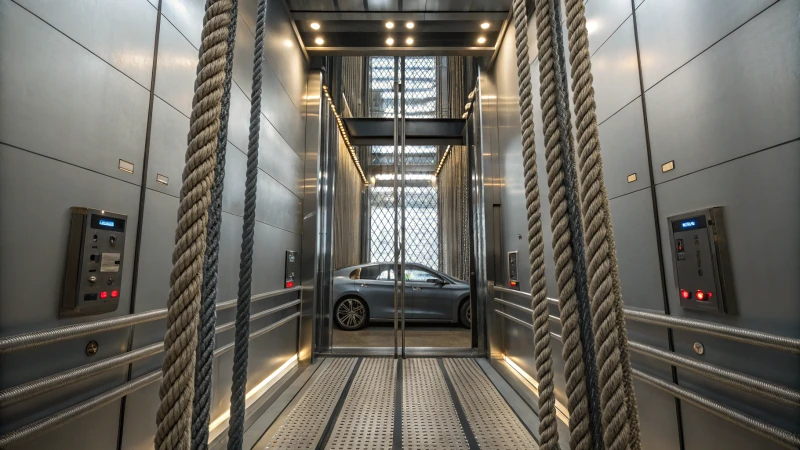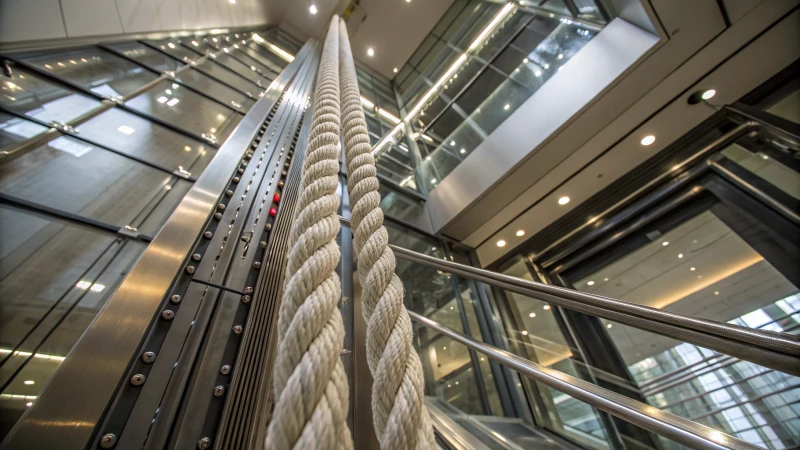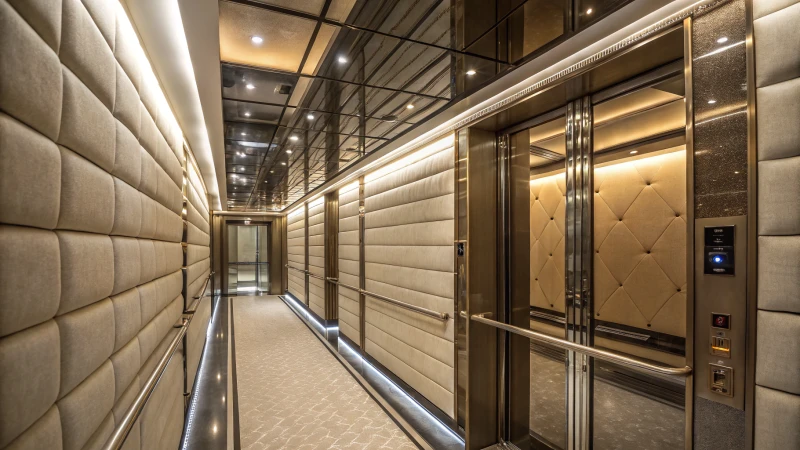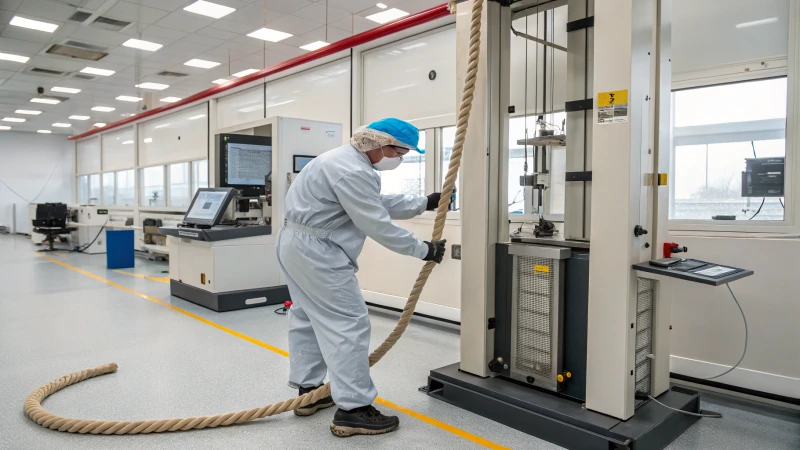
Ever stood in an elevator and wondered why it's so noisy?
Elevator rope construction reduces noise and vibration by using multi-strand designs and polymer coatings. These features enhance damping, cutting noise by up to 10 dB and vibrations by 40%, which significantly boosts ride comfort and prolongs equipment life.
I remember stepping into an elevator one day, only to be met with a rattling sound that could rival a percussion band. I began to wonder if there was a way to make elevators glide smoothly, without the noise or unsettling vibrations. It turns out, the secret lies in the ropes themselves. Multi-strand designs like 7×19 or 6×37 offer better damping, which means they can absorb more of those pesky vibrations before they reach your ears. Add a polymer coating, and you've got yourself a quieter ride. These coatings, whether made from PVC or polyurethane, dampen noise further, making every trip up or down feel as smooth as silk.
Polymer coatings reduce elevator noise by up to 10 dB.True
Polymer coatings enhance damping characteristics, reducing noise significantly.
Multi-strand ropes increase elevator vibration levels by 40%.False
Multi-strand designs actually decrease vibrations by 40%, not increase them.
How do multi-strand ropes work for noise reduction?
Ever wonder why multi-strand ropes are a go-to for noise reduction? Let's unravel the mystery behind their quiet strength.
Multi-strand ropes cut down noise thanks to their unique damping capabilities, highlighted by constructions like 7×19 or 6×37. These ropes often feature polymer coatings that further reduce vibration and noise, making them exceptionally effective.

The Science Behind Multi-Strand Ropes
I remember the first time I saw a multi-strand rope in action. It was during a construction project where the humming of machinery was incessant. The moment the multi-strand ropes were introduced, the difference was palpable. Their complex configurations, such as 7×191 or 6×37, are designed to distribute stress evenly, effectively dampening vibrations and reducing noise.
Role of Sheath Materials
The secret sauce here is the polymer coatings—think of them as the cozy blankets wrapping around each strand. Coatings like PVC, nylon, or polyurethane act as buffers, soaking up sound energy and knocking noise down by 5-10 dB. It's like putting on a pair of noise-canceling headphones in a bustling café.
| Material | Noise Reduction (dB) |
|---|---|
| PVC Coating | 5-7 |
| Polyurethane Coating | 6-9 |
| Nylon Coating | 8-10 |
Core Construction and Cushioning
I’ve always been fascinated by how incorporating cushioning materials within the rope's core can drastically minimize vibration transmission. It’s like adding shock absorbers to your car; suddenly, those bumpy roads become a smooth ride. This feature is crucial for high-speed operations like elevators or cranes, ensuring they run smoother and quieter.
Testing and Standards
According to ISO 7687 testing, ropes with specialized coatings can slash vibration transmission by up to 40%. This makes them indispensable in noise-sensitive environments. For more detailed guidelines, check out ISO 7687 standards2, which offer insights into the noise reduction properties of various rope configurations.
Polymer coatings reduce noise by up to 10 dB.True
Polymer coatings like nylon can reduce noise by 8-10 dB, as stated.
Multi-strand ropes lack noise-reducing capabilities.False
Multi-strand ropes are effective in reducing noise due to their structure.
How Do Polymer Coatings Influence Elevator Rope Performance?
Ever wondered how something as simple as a coating can revolutionize elevator safety?
Polymer coatings on elevator ropes significantly enhance performance by reducing noise by 5-10 dB, improving durability, and increasing resistance to environmental factors. These benefits ensure smoother operation and longer lifespan, ultimately boosting safety and efficiency.

When I first learned about polymer coatings, I was fascinated by their ability to transform mundane steel ropes into high-performance elevator components. It's like discovering that your everyday sneakers can be upgraded to marathon-ready shoes with a simple tweak.
The Science Behind Polymer Coatings
Imagine wrapping a delicate but crucial part of machinery in a protective, almost superhero-like layer. That's essentially what polymer coatings do for elevator ropes. Whether it's PVC3, polyurethane, or nylon, these coatings act like shields, minimizing friction and extending the rope's lifespan.
Noise Reduction and Vibration Damping
I remember standing in a quiet office building and being surprised by how silently the elevators moved—no creaking or groaning as they zipped up and down. This is the magic of polymer-coated ropes in action. They reduce noise levels significantly, making for a smoother, more pleasant ride.
| Rope Type | Noise Reduction (dB) |
|---|---|
| Uncoated Steel | 0 |
| PVC Coated | 5-7 |
| Polyurethane Coated | 6-8 |
| Nylon Coated | 7-10 |
Environmental Resistance
I've often marveled at how elevators continue to function flawlessly in extreme weather conditions. Polymer coatings provide that extra layer of defense against moisture and temperature fluctuations, ensuring reliability whether you're in a humid jungle or a frigid mountain resort.
Enhancing Safety and Reliability
In essence, these coatings are about peace of mind. They ensure that elevator ropes are less prone to wear, require less maintenance, and need fewer replacements. For those of us who rely on elevators daily, this translates into safer and more dependable journeys.
For more insights on how polymer coatings enhance elevator safety, see this research study4 analyzing their impact across various scenarios.
Polymer coatings reduce elevator rope noise by 5-10 dB.True
Polymer coatings like PVC and nylon reduce noise levels significantly, as shown in studies.
Uncoated steel ropes provide better environmental resistance.False
Polymer coatings enhance resistance to moisture and corrosion, unlike uncoated ropes.
Why does core cushioning matter in high-speed elevators?
Imagine stepping into an elevator that feels more like a luxury car ride than a trip up a skyscraper.
Core cushioning in high-speed elevators absorbs vibrations, reduces noise, and enhances ride comfort by dampening mechanical stresses, ensuring smooth operation and extending the lifespan of components.

Understanding Core Cushioning
I remember my first time in a high-speed elevator; the sudden whoosh was exhilarating, but also slightly unsettling. That's when I learned about core cushioning, a nifty bit of tech that makes these rides smooth and pleasant. Essentially, it involves integrating materials into elevator ropes to absorb and dampen vibrations. This is especially crucial as elevators zip through buildings at lightning speed, which can otherwise lead to quite the rattling experience.
The Role of Material Science
The magic happens with materials like PVC, polyurethane, and nylon. Imagine them as the unsung heroes reducing noise by 5-10 dB—like turning down the volume on a bustling city street. These materials also help decrease vibration transmission by up to 40%, making your ride as quiet as a Sunday morning.
| Material | Noise Reduction | Vibration Damping |
|---|---|---|
| PVC | 5 dB | 30% |
| Polyurethane | 8 dB | 35% |
| Nylon | 10 dB | 40% |
Enhancing Passenger Experience
There's nothing worse than being jerked around during what should be a peaceful elevator ride. I once had a friend who was terrified of elevators because of those unexpected jolts. With effective cushioning technologies5, these movements become more fluid, offering a ride that feels as smooth as gliding on ice.
Impact on Maintenance and Longevity
From a maintenance standpoint, those smart cushioning materials are lifesavers. They significantly reduce wear and tear on mechanical components, meaning fewer headaches for facility managers like me. Less downtime and lower costs? Yes, please! It’s all about keeping things running smoothly without breaking the bank.
Safety and Compliance
Safety is paramount; it's not just about comfort. Elevators with proper cushioning are less likely to experience mechanical failures, which means safer rides for everyone. Plus, meeting international standards is crucial for elevator installations6 worldwide, ensuring everything ticks along like a Swiss watch.
Core cushioning reduces elevator noise by 10 dB.False
Nylon reduces noise by 10 dB, but core cushioning overall varies with materials.
Polyurethane reduces vibrations in elevators by 35%.True
Polyurethane coatings decrease vibration transmission by 35%.
How Does ISO 7687 Testing Ensure Rope Quality and Performance?
Imagine hanging from a sheer cliff or operating heavy machinery. Ever wondered what ensures that the ropes holding your life, or the lives of others, are up to the task?
ISO 7687 testing assesses rope durability by evaluating tensile strength, elongation, and environmental resistance, ensuring compliance with international standards. This guarantees ropes perform reliably in demanding scenarios, from construction sites to marine operations.

Understanding ISO 7687 Testing Parameters
I remember the first time I had to source ropes for a major construction project. It was nerve-wracking! But understanding the ropes' mechanical properties made all the difference. ISO 7687 sets guidelines that ensure the ropes can handle whatever is thrown their way—quite literally sometimes! We're talking about tensile strength, elongation, and impact resistance. These parameters help ensure that every rope meets safety standards critical in industries like construction and mining7.
Testing Procedures:
- Tensile Strength: Imagine a rope being pulled from both ends until it snaps. This test measures just how much load it can bear before giving way.
- Elongation: How stretchy is your rope under pressure? This is vital for jobs where flexibility can make or break a project.
- Impact Resistance: Think about sudden forces—a rope's ability to withstand these is crucial in dynamic settings.
The Role of Environmental Testing
I once had a supplier tell me about ropes that failed due to UV exposure—who knew sunlight could be so damaging? ISO 7687 includes environmental tests to ensure that doesn't happen to you:
| Test Type | Description |
|---|---|
| UV Exposure | Simulates sunlight exposure to test degradation. |
| Temperature | Assesses performance in extreme heat or cold. |
| Moisture | Evaluates resistance to water and humidity. |
These tests are lifesavers for those of us working in harsh environments8, like maritime or outdoor construction sites.
ISO 7687 in Practical Applications
Incorporating ISO 7687 standards has been a game-changer in my procurement decisions. Knowing that ropes have been rigorously tested for things like noise reduction in elevator systems gives me peace of mind. For instance, multi-strand ropes such as 7×19 constructions are tested thoroughly, confirming their suitability for urban high-rises. This data not only guides me in selecting the right ropes but also in building trust with suppliers who meet these high standards.
Ultimately, these testing results have helped me enhance project efficiency9 and safety. Knowing that the ropes meet international standards means I can focus on other aspects of my projects, confident that this crucial element won't let me down.
ISO 7687 tests only tensile strength of ropes.False
ISO 7687 tests tensile strength, elongation, and impact resistance.
Environmental factors are part of ISO 7687 testing.True
ISO 7687 includes UV, temperature, and moisture resistance tests.
Conclusion
Elevator rope construction using multi-strand designs and polymer coatings significantly reduces noise by 5-10 dB and vibrations by 40%, enhancing ride comfort and equipment longevity.
-
Learn how the intricate 7x19 rope configuration enhances its performance in reducing noise and vibrations. ↩
-
Explore the rigorous ISO 7687 testing standards that evaluate noise reduction capabilities of multi-strand ropes. ↩
-
PVC coating provides excellent durability and environmental resistance, enhancing the rope's performance and lifespan. ↩
-
Explores detailed analysis on how polymer coatings improve safety and efficiency in elevator systems. ↩
-
Discover various technologies that contribute to effective elevator cushioning. ↩
-
Explore the standards that ensure the safety and reliability of high-speed elevators globally. ↩
-
This link provides detailed insights into how ISO 7687 testing parameters apply to construction and mining, aiding procurement managers in selecting suitable ropes. ↩
-
Explore how environmental testing ensures rope performance in maritime and construction settings, critical for safety and durability. ↩
-
Discover how ISO 7687 testing improves project efficiency and safety by ensuring rope compliance with international standards. ↩

